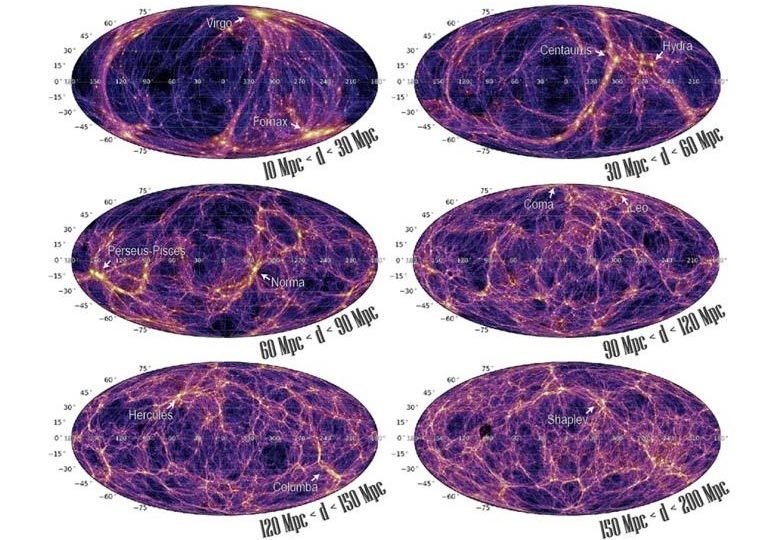Dans leur quête de compréhension de l’évolution cosmique, les scientifiques s’appuient sur une approche à deux volets. À l’aide d’instruments de pointe, les relevés astronomiques tentent de regarder de plus en plus loin dans l’espace (et dans le temps) pour étudier les périodes les plus anciennes de l’Univers. Parallèlement, les scientifiques créent des simulations qui tentent de modéliser l’évolution de l’Univers sur la base de notre compréhension de la physique. Lorsque les deux correspondent, les astrophysiciens et les cosmologistes savent qu’ils sont sur la bonne voie !
Ces dernières années, des simulations de plus en plus détaillées ont été réalisées à l’aide de superordinateurs de plus en plus sophistiqués, qui ont donné des résultats de plus en plus précis. Récemment, une équipe internationale de chercheurs dirigée par l’Université d’Helsinki a réalisé les simulations les plus précises à ce jour. Connu sous le nom de SIBELIUS-DARKces simulations ont prédit avec précision l’évolution de notre coin du cosmos depuis le Big Bang to the present day.
In addition to the University of Helsinki, the team was comprised of researchers from the Institute for Computational Cosmology (ICC) and the Centre for Extragalactic Astronomy at Durham University, the Lorentz Institute for Theoretical Physics at Leiden University, the Institut d’Astrophysique de Paris, and The Oskar Klein Centre at Stockholm University. The team’s results are published in the Monthly Notices of the Royal Astronomical Society.

Images of the SIBELIUS-DARK simulation. Credit: McAlpine et al. (2021)
This simulation is the first study conducted as part of the “Simulations Beyond the Local Universe” (SIBELIUS) project and was performed using the DiRAC COSmology MAchine (COSMA), a distributed computer network operated by the ICC. The simulation covers a volume of space up to a distance of 600 million light-years from Earth and is represented by over 130 billion simulated ‘particles’, which required thousands of computers several weeks to produce.
The team used known physics to describe how Dark Matter and cosmic gas evolved during the history of the Universe. Specifically, they sought to determine if what we observe today is consistent with the standard model of cosmology – the Cold Dark Matter (CDM) model. For the past few decades, astrophysicists have used this model to explain the properties of the Cosmic Microwave Background (CMB) to the number and spatial distribution of the galaxies we see today.
Previous CDM simulations have typically modeled random patches of the Universe that are similar to what we observe today. By using advanced generative algorithms, these simulations were conditioned to reproduce our specific patch of the Universe. This allowed the team to see if their simulation reproduced the present-day structures in the vicinity of the Milky Way that astronomers have observed for decades.
After meticulously comparing the virtual Universe they created to a series of observational surveys, they found that the simulation matched the locations and properties of structures like the Virgo, Coma, and Perseus galaxy clusters, the “Great Wall,” and the “Local Void.” Most importantly, at the center of the simulation were the two most important and familiar structures to astronomers: the virtual counterparts of the Milky Way and the neighboring Andromeda galaxy.

At the very center of the simulation is the Milky Way galaxy (MW) and our nearest massive neighbour, the Andromeda galaxy (M31). Credit: Dr. Stuart McAlpine
As co-author Professor Carlos Frenk (the Ogden Professor of Fundamental Physics at the ICC) explained:
“It is immensely exciting to see the familiar structures that we know exist around us emerge from a computer calculation. The simulations simply reveal the consequences of the laws of physics acting on the dark matter and cosmic gas throughout the 13.7 billion years that our universe has been around.
“The fact that we have been able to reproduce these familiar structures provides impressive support for the standard Cold Dark Matter model and tells us that we are on the right track to understand the evolution of the entire Universe.”
Another interesting finding was the prediction that our patch of the Universe has fewer galaxies on average due to a large-scale “matter underdensity.” While this does not contradict the CDM model, it could have consequences for astrophysicists interpreting observed galaxy surveys. “This project is truly ground-breaking,” said co-author Dr. Matthieu Schaller from Leiden University. “These simulations demonstrate that the standard Cold Dark Matter Model can produce all the galaxies we see in our neighborhood. This is a very important test for the model to pass.”
Dr. Stuart McAlpine, a former Ph.D. student at Durham and a current postdoctoral researcher at the University of Helsinki, added: “By simulating our Universe, as we see it, we are one step closer to understanding the nature of our cosmos. This project provides an important bridge between decades of theory and astronomical observations.”
Moving forward, the international team plans to further analyze the simulation in the hopes of providing further stringent tests of the CDM model.
Originally published on Universe Today.



